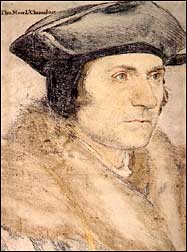|
|
|
|

Holbein's sketch of Thomas More
Sir Thomas More's Last Letter
Sir Thomas More's last letter, on "such little pieces of paper as he could obtain by stealth, on which he wrote with a coal," was written from prison on the day before his execution for treason. It was to his daughter Margaret, and shows Thomas More's great love for his family. It is also apparent from this letter that More was completely at peace with his impending death, and longed to "go to God" on the following day.
Source:
Walter, W. Joseph. Sir Thomas More: His Life and Times. 2nd Ed.
London: Charles Dolman, 1840. 345-7.
Monday, July 5th, 1535.—
MY GOOD DAUGHTER:
Our Lord bless you, my good daughter, and your good husband, and your little boy, and all yours, and all my children, and all my god-children, and all our friends. Recommend me when ye may, to my good daughter Cecily, whom I beseech Our Lord to comfort. And I send her my blessing, and to all her children, and beg her to pray for me. I send her a handkerchief; and God comfort my good son, her husband. My good daughter Daunce hath the picture in parchment, that you delivered me from my Lady Conyers; her name is on the back of it. Shew her that I heartily pray her, that you may send it in my name to her again, for a token from me to pray for me. I like especially well Dorothy Colly; I pray you be good unto her. I would wit [know] whether that be she you wrote me of; if not, yet I pray you be good to the other as you may, in her affliction, and to my good daughter Joan Aleyn too. Give her, I pray you, some kind answer, for she sued hither to me this day, to pray you to be good to her. I cumber you, good Margaret, much, and I should be sorry if it were to be any longer than to-morrow: for it is St. Thomas's even, and the utas [vigil] of St. Peter; and therefore to-morrow long I to go to God: it were a day very meet and convenient for me.—I never liked your manner towards me better, than when you kissed me last,* for I like when daughterly love and dear charity have no leisure to look to worldly courtesy. Farewell, my dear child, and pray for me, and I shall for you, and for all your friends, that we may merrily meet in heaven. I thank you for your great cost. I send now to my good daughter Clement her algorism stone,† and send her and my godson, and all hers, God's blessing and mine. I pray you, at time convenient, recommend me to my good son John More; I liked well his natural fashion. Our Lord bless him, and his good wife, my loving daughter, to whom I pray him to be good, as he hath great cause; and if the land of mine come to his hand, he break not my will concerning his sister Daunce. And our Lord bless Thomas and Austen, and all that they shall have.
* Here, he alludes to the affecting scene on Tower-wharf.
† An algorism stone was a device used for learning arithmetic, something in the nature of the multiplication table.
 |
to the Works of Sir Thomas More |
Site copyright ©1996-2018 Anniina Jokinen. All
Rights Reserved.
Created by Anniina Jokinen
on January 9, 2007. Last updated on May 29, 2009. Last updated on December 11, 2018.
|
|
The Tudors
King Henry VII
Elizabeth of York
King Henry VIII
Queen Catherine of Aragon
Queen Anne Boleyn
Queen Jane Seymour
Queen Anne of Cleves
Queen Catherine Howard
Queen Katherine Parr
King Edward VI
Queen Mary I
Queen Elizabeth I
Henry Fitzroy, Duke of Richmond
Renaissance English Writers
Bishop John Fisher
William Tyndale
Sir Thomas More
John Heywood
Thomas Sackville
Nicholas Udall
John Skelton
Sir Thomas Wyatt
Henry Howard
Hugh Latimer
Thomas Cranmer
Roger Ascham
Sir Thomas Hoby
John Foxe
George Gascoigne
John Lyly
Thomas Nashe
Sir Philip Sidney
Edmund Spenser
Richard Hooker
Robert Southwell
Robert Greene
George Peele
Thomas Kyd
Edward de Vere
Christopher Marlowe
Anthony Munday
Sir Walter Ralegh
Thomas Hariot
Thomas Campion
Mary Sidney Herbert
Sir John Davies
Samuel Daniel
Michael Drayton
Fulke Greville
Emilia Lanyer
William Shakespeare
Persons of Interest
Cardinal Thomas Wolsey
Archbishop Thomas Cranmer
Thomas Cromwell
John Fisher, Bishop of Rochester
Cardinal Lorenzo Campeggio
Cardinal Reginald Pole
Stephen Gardiner, Bishop of Winchester
William Tyndale
Pico della Mirandola
Desiderius Erasmus
Christopher Saint-German
Thomas Linacre
William Grocyn
Hugh Latimer
Elizabeth Barton, the Nun of Kent
For more, visit Encyclopedia
Historical Events
Field of the Cloth of Gold, 1520
Pilgrimage of Grace, 1536
The Babington Plot, 1586
The Spanish Armada, 1588
Government
Oath of Supremacy
The Act of Supremacy, 1534
The First Act of Succession, 1534
The Third Act of Succession, 1544
The Ten Articles, 1536
The Six Articles, 1539
The Second Statute of Repeal, 1555
Images of London:
London in the time of Henry VII. MS. Roy. 16 F. ii.
London, 1510, earliest view in print
Map of England from Saxton's Descriptio Angliae, 1579
Location Map of Elizabethan London
Plan of the Bankside, Southwark, in Shakespeare's time
Detail of Norden's Map of the Bankside, 1593
Bull and Bear Baiting Rings from the Agas Map (1569-1590, pub. 1631)
Sketch of the Swan Theatre, c. 1596
Westminster in the Seventeenth Century, by Hollar
Visscher's Panoramic View of London, 1616. COLOR
For more, visit Encyclopedia
|
|